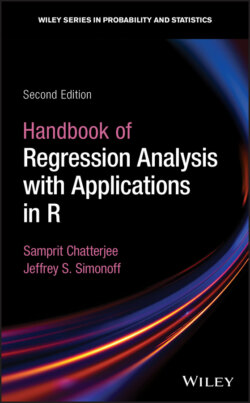Читать книгу Handbook of Regression Analysis With Applications in R - Samprit Chatterjee - Страница 24
1.3.5 CHECKING ASSUMPTIONS USING RESIDUAL PLOTS
ОглавлениеAll of these tests, intervals, predictions, and so on, are based on the belief that the assumptions of the regression model hold. Thus, it is crucially important that these assumptions be checked. Remarkably enough, a few very simple plots can provide much of the evidence needed to check the assumptions.
1 A plot of the residuals versus the fitted values. This plot should have no pattern to it; that is, no structure should be apparent. Certain kinds of structure indicate potential problems:A point (or a few points) isolated at the top or bottom, or left or right. In addition, often the rest of the points have a noticeable “tilt” to them. These isolated points are unusual observations and can have a strong effect on the regression. They need to be examined carefully and possibly removed from the data set.An impression of different heights of the point cloud as the plot is examined from left to right. This indicates potential heteroscedasticity (nonconstant variance).
2 Plots of the residuals versus each of the predictors. Again, a plot with no apparent structure is desired.
3 If the data set has a time structure to it, residuals should be plotted in time order. Again, there should be no apparent pattern. If there is a cyclical structure, this indicates that the errors are not uncorrelated, as they are supposed to be (that is, there is potentially autocorrelation in the errors).
4 A normal plot of the residuals. This plot assesses the apparent normality of the residuals, by plotting the observed ordered residuals on one axis and the expected positions (under normality) of those ordered residuals on the other. The plot should look like a straight line (roughly). Isolated points once again represent unusual observations, while a curved line indicates that the errors are probably not normally distributed, and tests and intervals might not be trustworthy.
Note that all of these plots should be routinely examined in any regression analysis, although in order to save space not all will necessarily be presented in all of the analyses in the book.
An implicit assumption in any model that is being used for prediction is that the future “looks like” the past; that is, it is not sufficient that these assumptions appear to hold for the available data, as they also must continue to hold for new data on which the estimated model is applied. Indeed, the assumption is stronger than that, since it must be the case that the future is exactly the same as the past, in the sense that all of the properties of the model, including the precise values of all of the regression parameters, are the same. This is unlikely to be exactly true, so a more realistic point of view is that the future should be similar enough to the past so that predictions based on the past are useful. A related point is that predictions should not be based on extrapolation, where the predictor values are far from the values used to build the model. Similarly, if the observations form a time series, predictions far into the future are unlikely to be very useful.
In general, the more complex a model is, the less likely it is that all of its characteristics will remain stable going forward, which implies that a reasonable goal is to try to find a model that is as simple as it can be while still accounting for the important effects in the data. This leads to questions of model building, which is the subject of Chapter 2.
